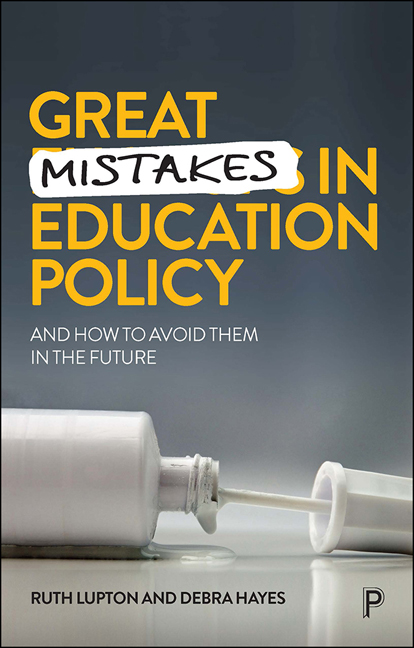Book contents
- Frontmatter
- Contents
- List of tables and boxes
- List of abbreviations
- Notes on the authors
- Acknowledgements
- 1 Introduction
- 2 Setting the scene
- 3 Tests, tests, tests
- 4 Schooling that works for some but not for others
- 5 Teachers making less of a difference
- 6 Mistake #1: turning to the market
- 7 Mistake #2: letting test scores drive policy
- 8 Mistake #3: over-prescribing teachers’ work
- 9 Mistake #4: misunderstanding educational inequalities
- 10 Mistake #5: leaving education out of education policy making
- 11 Synthetic phonics: a ‘perfect storm’ of policy mistakes
- 12 There are alternatives
- References
- Index
7 - Mistake #2: letting test scores drive policy
Published online by Cambridge University Press: 23 December 2021
- Frontmatter
- Contents
- List of tables and boxes
- List of abbreviations
- Notes on the authors
- Acknowledgements
- 1 Introduction
- 2 Setting the scene
- 3 Tests, tests, tests
- 4 Schooling that works for some but not for others
- 5 Teachers making less of a difference
- 6 Mistake #1: turning to the market
- 7 Mistake #2: letting test scores drive policy
- 8 Mistake #3: over-prescribing teachers’ work
- 9 Mistake #4: misunderstanding educational inequalities
- 10 Mistake #5: leaving education out of education policy making
- 11 Synthetic phonics: a ‘perfect storm’ of policy mistakes
- 12 There are alternatives
- References
- Index
Summary
The second policy move that we describe as a mistake is the over-focus in the education system on producing ever higher test scores.
Test scores should have a place in education policy. They can tell us about what is being achieved and how it matches up to what our societies and economies need from schooling. They can highlight groups of students who are doing less well out of the system and indicate where extra investment is needed. They can inform decisions about the effectiveness of different educational practices and help teachers to work effectively. Most people also acknowledge that students’ scores can also serve useful purposes in holding schools to account, representing the interests of children, young people, parents and communities and ensuring that public money is being spent well and wisely.
However, over recent decades, test scores have come to dominate education policy decisions. They have become the reasoning arguments or ‘logos’ of educational policy making, in a shift described by policy sociologist Professor Bob Lingard as ‘policy as numbers’ (Lingard, 2011, p 356). In this chapter, we trace this shift in England and Australia. We explain why it has come about and why the evidence demonstrates that it is a mistake.
‘Policy as numbers’ in England and Australia
In his key book on education policy, The Education Debate (Ball, 2017), Professor Stephen Ball identifies the start of the ‘policy as numbers’ phenomenon in England in the creation of the government's Assessment of Performance Unit (APU) in 1975. APU was tasked with developing methods of assessing and monitoring achievement and identifying the incidence of underachievement – a controversial move at the time as it was seen to erode teachers’ responsibility for curriculum development and assessment. But it was the 1988 ERA that gave tests and their outcomes a much more central role in education policy. ERA established the national curriculum and its SATs. In Australia, this move to a national curriculum and assessment programme came in 2008 with the establishment of NAPLAN. Prior to this, states and territories conducted literacy and numeracy testing programmes for all students in at least Years 3 and 5, but results were not used for the purpose of comparing schools – not publicly at least.
- Type
- Chapter
- Information
- Great Mistakes in Education PolicyAnd How to Avoid Them in the Future, pp. 81 - 94Publisher: Bristol University PressPrint publication year: 2021



